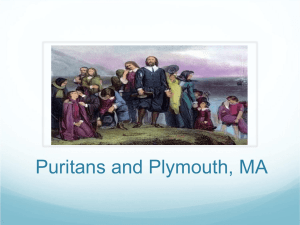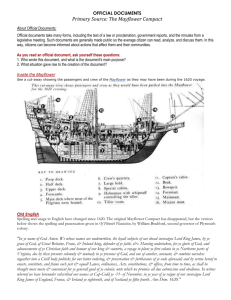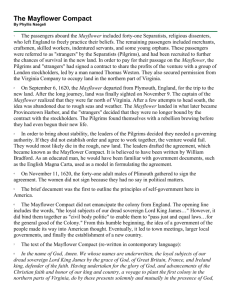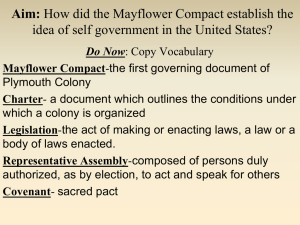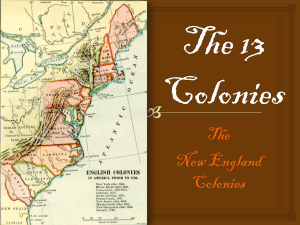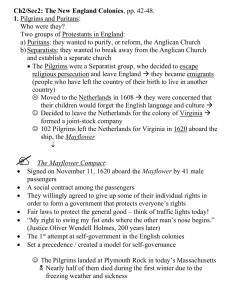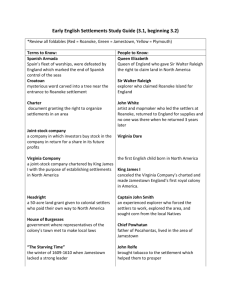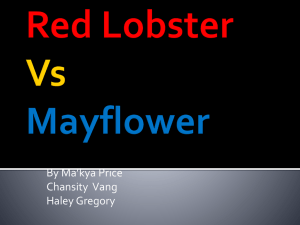Mayflower Compact : 1620
advertisement
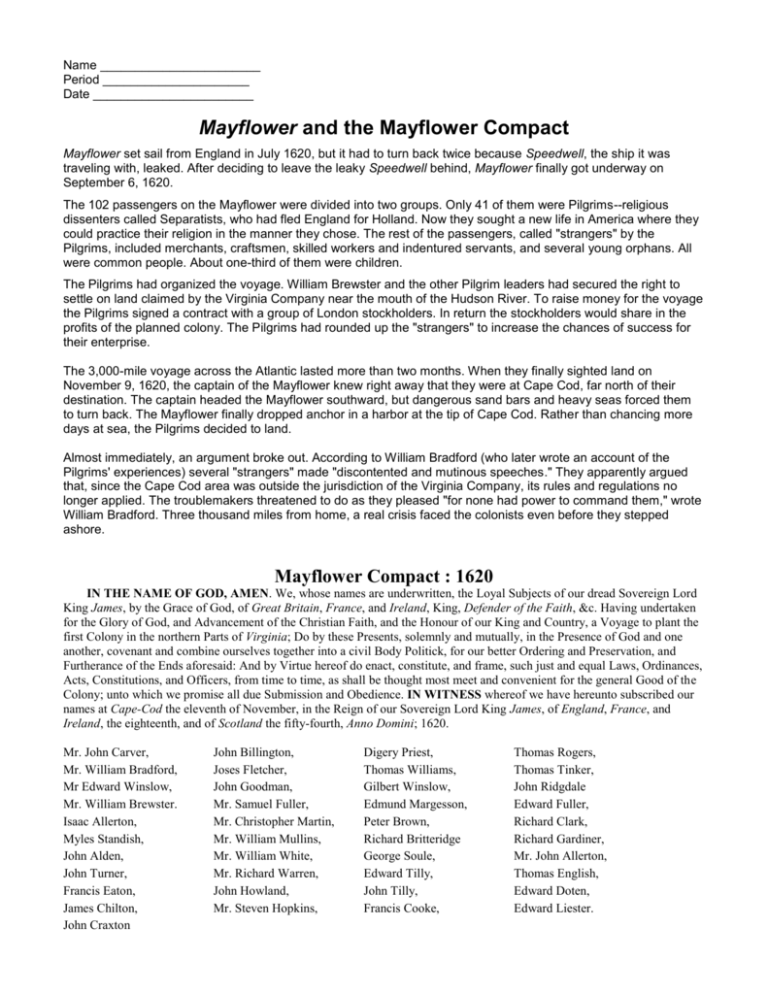
Name _______________________ Period _____________________ Date _______________________ Mayflower and the Mayflower Compact Mayflower set sail from England in July 1620, but it had to turn back twice because Speedwell, the ship it was traveling with, leaked. After deciding to leave the leaky Speedwell behind, Mayflower finally got underway on September 6, 1620. The 102 passengers on the Mayflower were divided into two groups. Only 41 of them were Pilgrims--religious dissenters called Separatists, who had fled England for Holland. Now they sought a new life in America where they could practice their religion in the manner they chose. The rest of the passengers, called "strangers" by the Pilgrims, included merchants, craftsmen, skilled workers and indentured servants, and several young orphans. All were common people. About one-third of them were children. The Pilgrims had organized the voyage. William Brewster and the other Pilgrim leaders had secured the right to settle on land claimed by the Virginia Company near the mouth of the Hudson River. To raise money for the voyage the Pilgrims signed a contract with a group of London stockholders. In return the stockholders would share in the profits of the planned colony. The Pilgrims had rounded up the "strangers" to increase the chances of success for their enterprise. The 3,000-mile voyage across the Atlantic lasted more than two months. When they finally sighted land on November 9, 1620, the captain of the Mayflower knew right away that they were at Cape Cod, far north of their destination. The captain headed the Mayflower southward, but dangerous sand bars and heavy seas forced them to turn back. The Mayflower finally dropped anchor in a harbor at the tip of Cape Cod. Rather than chancing more days at sea, the Pilgrims decided to land. Almost immediately, an argument broke out. According to William Bradford (who later wrote an account of the Pilgrims' experiences) several "strangers" made "discontented and mutinous speeches." They apparently argued that, since the Cape Cod area was outside the jurisdiction of the Virginia Company, its rules and regulations no longer applied. The troublemakers threatened to do as they pleased "for none had power to command them," wrote William Bradford. Three thousand miles from home, a real crisis faced the colonists even before they stepped ashore. Mayflower Compact : 1620 IN THE NAME OF GOD, AMEN. We, whose names are underwritten, the Loyal Subjects of our dread Sovereign Lord King James, by the Grace of God, of Great Britain, France, and Ireland, King, Defender of the Faith, &c. Having undertaken for the Glory of God, and Advancement of the Christian Faith, and the Honour of our King and Country, a Voyage to plant the first Colony in the northern Parts of Virginia; Do by these Presents, solemnly and mutually, in the Presence of God and one another, covenant and combine ourselves together into a civil Body Politick, for our better Ordering and Preservation, and Furtherance of the Ends aforesaid: And by Virtue hereof do enact, constitute, and frame, such just and equal Laws, Ordinances, Acts, Constitutions, and Officers, from time to time, as shall be thought most meet and convenient for the general Good of the Colony; unto which we promise all due Submission and Obedience. IN WITNESS whereof we have hereunto subscribed our names at Cape-Cod the eleventh of November, in the Reign of our Sovereign Lord King James, of England, France, and Ireland, the eighteenth, and of Scotland the fifty-fourth, Anno Domini; 1620. Mr. John Carver, Mr. William Bradford, Mr Edward Winslow, Mr. William Brewster. Isaac Allerton, Myles Standish, John Alden, John Turner, Francis Eaton, James Chilton, John Craxton John Billington, Joses Fletcher, John Goodman, Mr. Samuel Fuller, Mr. Christopher Martin, Mr. William Mullins, Mr. William White, Mr. Richard Warren, John Howland, Mr. Steven Hopkins, Digery Priest, Thomas Williams, Gilbert Winslow, Edmund Margesson, Peter Brown, Richard Britteridge George Soule, Edward Tilly, John Tilly, Francis Cooke, Thomas Rogers, Thomas Tinker, John Ridgdale Edward Fuller, Richard Clark, Richard Gardiner, Mr. John Allerton, Thomas English, Edward Doten, Edward Liester. Imagine the situation: over 100 people, cut off from any government, with a rebellion brewing. Only staunch determination would help the Pilgrims land and establish their colony. If they didn't work as a group, they could all die in the wilderness. The Pilgrim leaders realized that they needed a temporary government authority. Back home, such authority came from the king. Isolated as they were in America, it could only come from the people themselves. Aboard the Mayflower, by necessity, the Pilgrims and "Strangers" made a written agreement or compact among themselves. The Mayflower Compact was probably composed by William Brewster, who had a university education, and was signed by nearly all the adult male colonists, including two of the indentured servants. The format of the Mayflower Compact is very similar to the written agreements used by the Pilgrims to establish their Separatist churches in England and Holland. Under these agreements the male adult members of each church decided how to worship God. They also elected their own ministers and other church officers. This pattern of church self-government served as a model for political self-government in the Mayflower Compact. The colonists had no intention of declaring their independence from England when they signed the Mayflower Compact. In the opening line of the Compact, both Pilgrims and "Strangers" refer to themselves as "loyal subjects" of King James. The rest of the Mayflower Compact is very short. It simply bound the signers into a "Civil Body Politic" for the purpose of passing "just and equal Laws . . . for the general good of the Colony." But those few words expressed the idea of self-government for the first time in the New World. Self-Government Takes Root Immediately after agreeing to the Mayflower Compact, the signers elected John Carver (one of the Pilgrim leaders) as governor of their colony. They called it Plymouth Plantation. When Governor Carver died in less than a year, William Bradford, age 31, replaced him. Each year thereafter the "Civil Body Politic," consisting of all adult males except indentured servants, assembled to elect the governor and a small number of assistants. Bradford was re-elected 30 times between 1621 and 1656. In the early years Governor Bradford pretty much decided how the colony should be run. Few objected to his oneman rule. As the colony's population grew due to immigration, several new towns came into existence. The roving and increasingly scattered population found it difficult to attend the General Court, as the governing meetings at Plymouth came to be called. By 1639, deputies were sent to represent each town at the other General Court sessions. Not only self-rule, but representative government had taken root on American soil. The English Magna Carta, written more than 400 years before the Mayflower Compact, established the principle of the rule of law. In England this still mostly meant the king's law. The Mayflower Compact continued the idea of law made by the people. This idea lies at the heart of democracy. From its crude beginning in Plymouth, self-government evolved into the town meetings of New England and larger local governments in colonial America. By the time of the Constitutional Convention, the Mayflower Compact had been nearly forgotten, but the powerful idea of self-government had not. Born out of necessity on the Mayflower, the Compact made a significant contribution to the creation of a new democratic nation.
